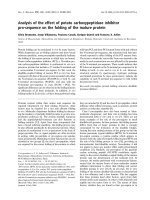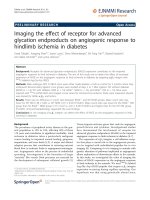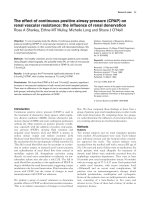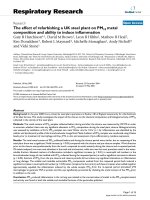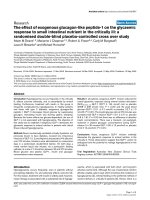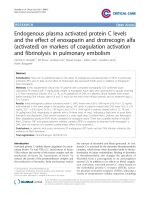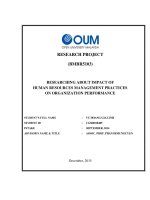The effect of green supply chain management practices on sustainability performance in Vietnamese construction materials manufacturing enterprises
Bạn đang xem bản rút gọn của tài liệu. Xem và tải ngay bản đầy đủ của tài liệu tại đây (731.82 KB, 12 trang )
Uncertain Supply Chain Management 8 (2020) 43–54
Contents lists available at GrowingScience
Uncertain Supply Chain Management
homepage: www.GrowingScience.com/uscm
The effect of green supply chain management practices on sustainability performance in
Vietnamese construction materials manufacturing enterprises
Thi Tam Lea*
a
Thuyloi University, 175 Tay Son, Dong Da, Hanoi, Vietnam
CHRONICLE
Article history:
Received July 25, 2019
Received in revised format
August 20, 2019
Accepted August 23 2019
Available online
August 23 2019
Keywords:
Green Supply Chain Management
Environmental Performance
Economic Performance
Social Performance
Construction Materials
ABSTRACT
Growing environmental concerns and social responsibility push organizations into seriously
considering their strategies in business operations. The implementation of green supply chain
management (GSCM) is a vital strategy which enables organizations to focus on minimizing
environmental issues, improving economic benefits and expanding social outcomes. The aim
of this paper is to examine the relationship between GSCM practices and sustainable
performance in Vietnamese construction materials manufacturing enterprises. Based on the
data collected from a sample of 218 construction materials manufacturers in Vietnam, the study
examines the impact of GSCM elements on firm performance including economic,
environmental and social using structural equation modeling. The study finds that green design
and green manufacturing had positive and significant effects on three categories of outcomes,
whereas green procurement impact on economic and social performance but had no influence
on environmental performance. The results also empirically prove that there was a positive
relationship between green distribution and environmental performance which is not supported
for economic and social perspective. The study also contributes significantly to an on-going
research associated with GSCM practices on sustainable performance in developing countries
such as Vietnam where very few studies of GSCM have been revealed.
© 2020 by the authors; license Growing Science, Canada.
1. Introduction
For sustainable development goal, businesses are increasingly interested in social parties and put more
attention on corporate social responsibility and environmental practices. Social and environmental
issues in supply chain have become the main concern of researchers. Green supply chain management
(GSCM) is an extremely useful tool for sustainable development and improved awareness of
environmental protection and social responsibility (Wang & Dai, 2017). Specially, in supply chain,
focal companies need to take social and environmental responsibility and help other companies in
supply chain to comply environmental standards. Any failure on such responsibilities may hurt firms’
reputation and other members in supply chain (Burritt et al., 2011). Therefore, enterprises should
implement GSCM practices to avoid and minimize the negative environmental and social effects of all
members among the supply chain (Neumüller et al., 2016).
In recent years, some emerging economic countries have realized potential role of environmental
protection and social responsibility in supply chain management such as Malaysia, Thailand, Egypt,
Iran (Eltayeb et al., 2011; Zailani et al., 2012; Laosirihongthong, et al. 2013; Khaksar et al., 2016;
* Corresponding author Tel: +84984537282
E-mail address: (T.T. Le)
© 2020 by the authors; licensee Growing Science.
doi: 10.5267/j.uscm.2019.8.007
44
Hamdy et al., 2018). Also, a few researches about GSCM practices in these countries from different
industry have been prevailed (Laosirihongthong, et al., 2013). Nevertheless, relevant studies in Asian
countries are not many (Arlbjørn & Lu¨ thje, 2012). For Vietnam, the adoptions of GSCM are still
relatively rare.
Construction materials industry in Vietnam contributes to 7.5% of gross domestic product (GDP) and
9% of the total employment every year. However, Vietnamese construction materials manufacturing
industry is one of the largest sectors consuming raw materials, energy and generating emission.
Construction wastes which arise from business activities including supply, manufacture, transportation,
create serious consequences for environment as well as economic and social impact. Therefore, saving
resources and green producing are a survival matter. For this purpose, Vietnamese government issues
regulations of 2014 on sustainable development planning of construction materials manufacturing
industry in the period from 2020 to 2030. However, opinions of green supply chain as well as GSCM
have not been received strong attention by policy makers, businesses and researchers. From literature,
the study observes the elements of GSCM practices and dissociates their impact on firm performance
in Vietnamese construction materials manufacturers. This study also significantly contributes to an ongoing research that relates to GSCM practices on sustainable performance in developing countries like
Vietnam where few researches of GSCM has been carried out.
2. Research Overview
GSCM practices
According to Zhu et al. (2008), GSCM has emerged as an effective management tool for proactive and
leading manufacturing firms. Although, GSCM plays a very important role in integration of
environmental and social issues into supply chain management in order to improve sustainable
outcomes, definitions of GSCM has only emerged since the end of the 1980s (Maloni & Brown, 2006).
Until the 1990s, researchers encouraged more responsible and comprehensive practices of
environmental concerns in supply chain management (Shi et al., 2012). Nevertheless, according to
Hajikhani et al. (2012), the implementation of GSCM actually occurred in 1994 beginning with green
procurement. Later, due to growing social and environmental concerns, GSCM application is expanded
in all phases of supply chain. GSCM is defined as the concept of environmental considerations in
internal environmental management; green purchase; customer cooperation; eco design; investment
recovery (Hamdy et al., 2018). Meanwhile Wibowo et al. (2018) argue that elements of GSCM practice
in construction industry consist of green initiation; green design; green construction; green operation
and maintenance; reverse logistics. Others such as Shukla (2017) claim that core GSCM practice
identified are green building design, green purchasing; green transportation; green construction and end
of life management. It seems that because of the conditions of different industries in various countries,
GSCM practice implicate different elements.
Many studies have provided various definitions for GSCM. In some instances, GSCM is add “green”
component to all phases of product’s life cycle from procurement, design, production and distribution
in order to maximize the performance in all dimensions (Yu, 2014; Dadhich et al., 2015). GSCM
implies that all components of the supply chain have the responsibility of minimizing negative impacts
to ensure long term benefits (Dadhich et al., 2015). As a result, the scope of GSCM practice ranges
from green procurement, green design, green manufacture to green distribution (Zhu et al., 2008;
Ghobakhloo et al., 2013; Hamdy et al., 2018). However, GSCM adoption is facing challenges when
individual stage in supply chain can impact on performance of other members. For example, green
procurement not only has a profound impact on core enterprise’s outcomes but also affects to supplier’s
performance. Core enterprises should extend management boundaries from traditional to supply chain
partners (Kytle & Ruggies, 2005; Wang & Dai, 2017). Building elements of GSCM practice is essential
in order to establish theoretical basis and to develop suitable research model especially when the scope
of GSCM in the literature is confused. Various studies can contribute comprehensive framework of
GSCM constructs which is enable us to detect appropriate constructs for specific sectors. Based on our
understanding of GSCM practice in construction materials manufacturing sector, we identify and
T.T. Le /Uncertain Supply Chain Management 8 (2020)
45
classify relevant green practice into four elements relating to supply chain stakeholders (suppliers,
designers, manufacturers, customers).
Green Procurement: The implementation of green purchasing is adopted first in GSCM practice
(Hajikhani et al., 2012). This definition indicates that the environmental considerations are linked to
purchasing planning, program and action (Varnäs et al., 2009). Green procurement involves the
purchasing of environmentally friendly products and the cooperation with suppliers for environmental
objectives. To meet suppliers’ environmental goals, buying enterprises needs collaboration activities
such as information sharing, joint research and training (Laosirihongthong et al., 2013). Similarly,
environmental integrations into purchase stage require that suppliers should possess ISO14001,
ISO9001 or EMS certification (Zhu et al., 2008; Laosirihongthong, et al. 2013; Esfahbodi et al., 2016).
In the selection phase, providing eco design specification to suppliers that include environmental
requirements for purchased items is allocated to the green aspects of the project (Zhu et al., 2008;
Esfahbodi et al., 2016).
Green Design: Designing green products creates chances to reduce the environmental effects in
constitution of new products or new production processes (Wibowo et al., 2018). Eco-design is
associated with health safety, product life cycle and sustainability (Chowdhury et al., 2016). Typically,
eco-design can help to diminish waste processing and recycling costs (Chen & Sheu, 2009). The
significant role of green design is supported by Büyüközkan and Çifçi (2012) disclosing that about 80%
of product impacts on the environment comes from design stage. Therefore, organizations make
positive and proactive plans to use recycled, reused and recovery components. Moreover, it is important
for organizations to ensure that design of products can reduce the consumption of hazardous products.
Green Manufacturing: The major target of green manufacturing is the deduction of resources
consumption with the aim of minimizing the amount of wastes by using appropriate materials, optimal
processes and cleaner technologies (Chowdhury et al., 2016; Wang & Dai, 2017; Wibowo et al., 2018).
Green production is a kind of production process that uses input with high efficiency and less
environmental effects (Amemba et al., 2013). In addition to that, enterprises increase production and
environmental efficiency in green manufacturing (Wibowo et al., 2018). Thanks to green production,
emissions and wastes are treated and disposed by environmental control equipment meanwhile through
cleaner technologies such as recycling, reuse or process innovation, emissions and wastes also are
decreased, changed and prevented (Ghobakhloo et al., 2013).
Green Distribution: According to Ghobakhaloo et al. (2013), green distribution is one of significant
components of GSCM because of its potential for positive environmental influence. Green distribution
can be defined as coordination for green packaging with customers (Zhu et al., 2008; Perotti et al.,
2012; Laari, 2016; Hamdy et al., 2018), upgrade freight logistics and transportation systems (Esfahbodi
et al., 2016; Laari, 2016) or track and monitor emissions in distributing products (Esfahbodi et al.,
2016).
Performance in adopting GSCM practice
GSCM practice is to incorporate environmental considerations into all stages of products through
purchase, design, production and distribution. Numerous studies have investigated the effects of
individual stage on corporate performance. For example, the findings of Shukla (2017) confirm that the
implementation of GSCM had a positive impact on environmental and economic performance while
Wang and Dai (2017) concur that there was a significantly positive relationship between GSCM
practice and environmental and social performance. Former articles suggest that three dimensions of
performance for GSCM applications consists of environmental, economic and social (Wang & Dai,
2017; Das, 2018). Nevertheless, different studies focus on GSCM for one or two of the performance.
According to Laosirihongthong et al. (2013), most previous researchers focus primarily on
environmental and economic outcomes such as Zhu et al. (2008), Green et al. (2012) and De Giovanni
and Vinzi (2012). Few papers consider all dimensions of sustainability simultaneously (economic,
environmental and social) (Wang & Dai, 2017). Furthermore, the impact of GSCM practice on social
46
dimension has been discussed in the literature mainly in relation to developed countries while this
relationship in developing economies remains relatively unexplored (Laosirihongthong et al., 2013).
This paper aims to analyze the relationship between GSCM practice and a variety of corporate
sustainability performance in Vietnamese construction materials manufacturers.
Environmental Performance: Previous researches have offered insights into the potential role of GSCM
practice for improving environmental performance (Eltayeb et al., 2011; Green et al., 2012; Lee et al.,
2012). Khaksar et al. (2016) state that GSCM is one of the central issues debated in operation
management and directly affects to environmental results. Environmental performance is measured by
several items which reflect through reduction of wastes, decrease of consumption for
hazardous/harmful/toxic materials and energy (De Giovanni & Vinzi, 2012; Yang et al., 2013; Laari,
2016). According to Zhu et al. (2008) and Das (2018), reduction in the frequency of environmental
accidents is another item of environmental performance. Moreover, improvement of an enterprise’s
environmental situation is supported by Esfahbodi et al. (2016).
Economic Performance: Viewpoints on GSCM practice having a negative or positive relationship with
economic performance are still confused (Wagner et al. 2002). Green et al. (2012) suggest that GSCM
practice by manufacturing organizations leads to improved environmental performance and economic
performance. These results are also confirmed by the studies of Yang et al. (2013) and Perotti et al.
(2012). However, according to Esfahbodi et al. (2016), adoption of GSCM results in higher levels of
environmental performance of manufacturers in China and Iran, but does not necessarily lead to
improved economic performance which is accepted by the results of De Giovanni and Vinzi (2012).
Economic performance implies in terms of saving costs including cost for materials purchasing, cost
for energy consumption, fee for waste treatment, fee for waste discharge and decrease of fine for
environmental accidents (Zhu et al., 2008; Zailani et al., 2012; Green et al., 2012; Das, 2018). Further,
improving profits is utilized by Laari (2016), Yang et al. (2013). Increasing market share is
recommended by Wagner and Schaltegger (2004); Perotti et al. (2012); De Giovanni & Vinzi (2012).
Social Performance
Social performance in supply chain management has received increasing attention due to increasing
awareness on health and safety, education in organizations (Seuring & Muller, 2008; Eriksson &
Svenssion, 2015). GSCM looks to improve social performance of companies in supply chain (Wang &
Dai, 2017). However, most of the empirical studies focus on GSCM deal with environmental and
economic sectors (Golicic & Smith, 2013). There are few empirical studies associated with social
sustainability in supply chain management (Mani et al., 2016a; 2016b). For example, Esfahbodi et al.
(2016) confirm the positive impact of GSCM on environmental and cost performance and did not
incorporate social performance. Thus, comprehensive GSCM practice performance model is proposed
and empirically assessed for Vietnamese construction materials production firms. Social performance
is measured in terms of increasing health care facilities to the local community (Hutchins & Sutherland,
2008; Main et al., 2016a, b, Das, 2018). According to Das (2018), social performance is also reflected
in improving employment/business opportunities to community. On the other hand, vocational/primary
education of the surrounding people advanced is supported by a few studies of Zhu et al., 2016; Das,
2018.
3. Research methodology and model
Many researchers have integrated environmental practice into supply chain management. GSCM is an
innovative tool to achieve sustainable development (Zhu et al., 2012; Chowdhury et al., 2016).
Although, GSCM practice is established by several theories, application of GSCM impacting on
performance depends on type of industries and different context (Chiou et al., 2011). For example,
Khaksar et al. (2016) only analyzed the impact of green supplier and green innovation on environmental
outcomes. Perotti et al. (2012) and Hamdy et al. (2018) examined how GSCM practice could contribute
to improve company performance from an environmental viewpoint as well as economic and
operational. On the other word, Zailani et al. (2012) select a research model which green procurement
T.T. Le /Uncertain Supply Chain Management 8 (2020)
47
and green packaging positively affect sustainable supply chain performance including operational,
economic, environmental and social performance. In the context of Vietnamese construction materials
industry, this study is conducted to investigate the relationship between GSCM practice and sustainable
performance (see Fig. 1). While the elements of GSCM practice consist of Green Procurement (GPR),
Green Design (GDE), Green Manufacturing (GMA), Green Distribution (GDI), sustainable
performance is measured by three sectors including environmental, economic and social performance.
GSCM practice
Sustainable Performance
Green Procurement
Economic
Performance
Green Design
Environmental
Performance
Green Manufacturing
Social Performance
Green Distribution
Fig. 1. Research model
Table 1
Scales of GSCM elements
Item
Description
Sources
Green Procurement (GPR)
GPR1
Green label of products
Vachon & Klassen (2008), Zhu et al. (2008),
Perotti et al. (2012), De Giovanni & Vinzi
GPR2
Collaboration with suppliers for environmental targets
GPR3
Require suppliers to adopt an environmental management system (eg. ISO 14001, (2012), Esfahbodi et al. (2016), Laari (2016),
Hamdy et al. (2018)
ISO 9001, EMS)
GPR4
Demand suppliers to provide design specification including environmental
requirements for purchased item
Green Design (GDE)
GDE1
Products designed to reduce consumption of material/energy
Zhu et al. (2008), Esfahbodi et al. (2016),
GDE2
Products designed to reuse, recycle, recovery of material, component parts
Hamdy et al. (2018)
GDE3
Products designed to avoid or reduce use of hazardous products
GDE4
Cooperation with customers for eco design
Green Manufacturing
GMA1
Optimization of manufacturing processes to reduce air emissions, water use, solid De Giovanni & Vinzi (2012), Zailani et al.
waste, and/or noise reduction
(2012), Wang & Dai (2017)
GMA2
Use of cleaner production technologies and best practices
GMA3
Establish the recycle system of waste products
Green Distribution
GDI1
Coordination with customers for green packaging
Zhu et al. (2008), Green et al. (2012), Perotti
GDI2
Reform logistics and transportation systems
et al. (2012), Yang et al. (2013), Esfahbodi et
GDI3
Track and monitor emissions caused in distributing products
al. (2016), Laari (2016), Hamdy et al. (2018)
A five-point scale: 1= not at all, 2= to a small extent, 3= to a moderate extent, 4= to a relatively great extent, 5= to a great extent
The instrument used for this study has been established according to literature. Each construct consists
of multiple items using five-point scale. In order to maintain that GSCM is applied and implemented
by respondent enterprises, the sample population is limited to construction materials manufacturers
receiving ISO 14001 or/and ISO9001 certification or/and setting environmental management system
(EMS) in Vietnam. The survey questionnaires are sent to managers relating to GSCM practices and
firm performance by email and directly. In original sample of 450 enterprises, we obtained 218 useful
and complete votes and response rate was by 48.44%. It is considered sufficient for implementing the
research hypotheses. Respondents were asked to indicate to what extent of GSCM practices
implemented and describe performance results in their enterprises based on a five-point Likert ranging
from 1 to 5. The measures are presented in Table 1 and Table 2. Collected data is processed by SPSS
22.0 software which provide reliability testing, factor analysis, correlation analysis and regression
analysis.
48
Table 2
Scales of GSCM performance
Item
Description
Sources
Economic Performance (EP)
ECP1
Increase Profit
Wagner and Schaltegger (2004), Zhu et al. (2008), Perotti et al.
(2012), De Giovanni & Vinzi (2012), Green et al. (2012), Yang et
ECP2
Save cost
al. (2013), Esfahbodi et al. (2016), Laari (2016), Das (2018)
ECP3
Increase market share
Environmental Performance (EP)
ENP1
Reduce wastes (such as air emission, solid wastes, waste water, Wagner and Schaltegger (2004), Zhu et al. (2008), De Giovanni &
noise pollution)
Vinzi (2012), Perotti et al. (2012), Yang et al. (2013), Esfahbodi
ENP2
Decrease consumption for hazardous/ harmful/toxic materials et al. (2016), Laari (2016), Das (2018), Hamdy et al. (2018)
and energy
ENP3
Reduce the frequency off environmental accident
ENP4
Improve enterprise’s environmental situations
Social Performance (SP)
SOP1
Increase health care facilities to the local community
Hutchin & Sutherland (2008), Main et al. (2016a,b), Wang & Dai
SOP2
Enhance opportunities for employment and business to the (2017), Das (2018)
surrounding community
SOP3
Improve professional education of the surrounding people
A five point scale: 1=not at all, 2=a little bit, 3= to some degree, 4= relatively significant and 5=significant
4. Research results
Measurement scales
Cronbach's Alpha, Corrected Item-Total Correlation and Cronbach's Alpha if Item Deleted are selected
to test the reliability of the scales. In Table 3, Cronbach's Alpha of each construct ranges from 0.852 to
0.930, corrected Item-Total Correlation value of the variables from 0.573 to 0.866 is greater than 0.3
and Cronbach's Alpha if Item Deleted value in this study between 0.738 and 0.948 is greater than 0.6.
It is indicated that all scales are acceptable with good reliability degree (Hair et al., 2014).
Table 3
Measurement scales
Item
Cronbach's Alpha
Green Procurement (GPR)
GPR1
GPR2
0.913
GPR3
GPR4
Green Design (GDE)
GDE1
GDE2
0.926
GDE3
GDE4
Green Manufacturing (GMA)
GMA1
GMA2
0.852
GMA3
Green Distribution (GDI)
GDI1
GDI2
0.889
GDI3
Economic Performance (ECP)
ECP1
ECP2
0.910
ECP3
Environmental Performance (ENP)
ENP1
ENP2
0.869
ENP3
ENP4
Social Performance (SOP)
SOP1
SOP2
0.930
SOP3
Extraction Sums
of Squared
Loadings
Factor loading
79.757%
.904
.889
.880
.876
0.855
81.857%
.868
.867
.866
.861
.948
.738
.684
0.632
78.726%
.932
.924
.517
.821
.741
.791
.808
.878
.835
0.735
81.865%
.920
.849
.769
.840
.866
.784
.855
.843
.921
0.740
85.958%
.946
.935
.900
.672
.759
.723
.747
.855
.817
.833
.822
0.825
72.102%
.871
.865
.848
.811
.860
.855
.856
.897
.900
.900
0.767
87.795%
.939
.936
.936
Corrected Item-Total
Correlation
Cronbach's Alpha if
Item Deleted
.796
.774
.833
.820
.892
.899
.875
.881
.846
.842
.840
.785
.897
.899
.899
.918
.573
.791
.837
KMO
0.788
In factor analysis, we use KMO value; extraction sums of squared loadings and factor loadings. KMO
value considers the appropriateness of factor analysis which is acceptable when it is greater than 0.5.
Table 3 shows that KMO values of all the seven constructs are higher than 0.5 with Sig. values of
T.T. Le /Uncertain Supply Chain Management 8 (2020)
49
Barlett’s tests by 0.000 (less than 0.01) proposing that factor analysis is appropriate. The scales for
Green Procurement construct explain 79.757% of the total variance in the data. The values for other
constructs are greater than 50% as follows: Green Design (81.857%); Green Manufacturing
(78.726%); Green Distribution (81.865%); Economic Performance (85.958%); Environmental
Performance (72.102%); Social Performance (87.795%) respectively. The values of extraction sums
of squared loadings are higher than the recommended critical value of 50% which confirm appropriate
exploratory factor analysis. In addition to that, factor loadings of all seven constructs are greater than
0.7 expectation of GMA3 (factor loading = 0.517) and at significant level of 0.01 indicating that the
observed variables have a close correlation with the factors for very good statistical significance (Hair
et al., 2014).
Correlation analysis
The study also examines whether there are significant correlation relationships between constructs. As
indicated in Table 4, all constructs are related to each other exception of Green Procurement and Green
Design which have no correlation due to Sig. value by 0.055 greater than 0.01. Green Procurement
have weak relationships with different constructs (Pearson Correlation < 0.5). The remaining constructs
have significant relationships (Pearson Correlation > 0.5). Especially, all three dimensions of GSCM
performance are highly correlated to each other. These imply that GSCM practices have an influence
on one dimension of performance are likely to impact on other dimensions.
Table 4
Correlation Analysis
GPR
GPR
1
Correlations
GDE
GMA
Pearson Correlation
Sig. (2-tailed)
GDE Pearson Correlation
.130
1
Sig. (2-tailed)
.055
GMA Pearson Correlation
.206** .513**
1
Sig. (2-tailed)
.002
.000
GDI Pearson Correlation
.188** .507**
.522**
Sig. (2-tailed)
.005
.000
.000
ECP Pearson Correlation
.341** .706**
.562**
Sig. (2-tailed)
.000
.000
.000
**
**
ENP Pearson Correlation
.271
.548
.601**
Sig. (2-tailed)
.000
.000
.000
SOP Pearson Correlation
.309** .764**
.561**
Sig. (2-tailed)
.000
.000
.000
**. Correlation is significant at the 0.01 level (2-tailed).
GDI
ECP
ENP
SOP
1
.512**
.000
.563**
.000
.526**
.000
1
.666**
.000
.914**
.000
1
.727**
.000
1
Regression analysis
This study adopts regression analysis to explore whether GSCM practices affect to dimensions of
performance. The first set of hypotheses investigates the relationships between four elements of GSCM
and economic performance as showed in H1 to H4. Adjusted R2 value is of 0.599 (> 0.5) which points
out the close relationships among constructs. The value of d in Durbin - Watson test is less than 2
showing there is no autocorrelations among the residuals. Table 5 displays that Green Procurement;
Green Design, Green Manufacturing have significant and positive relationships with Economic
Performance. which support for H1, H2, H3. In contrast, the findings indicate that Green Distribution
have no relationship with Economic Performance because of Sig. value of 0.056 (less than 0.01).
50
Table 5
Regression model between GSCM practices and economic performance
Model
1
(Constant)
Unstandardized
Coefficients
B
Std. Error
Standardized
Coefficients
t
99.0% Confidence
Interval for B
Sig.
Beta
Lower
Bound
Upper
Bound
Collinearity Statistics
Tolerance
VIF
-1.385
.327
-4.241
.000
-2.234
-.536
GPR
.274
.057
.213
4.834
.000
.127
.422
.949
1.054
GDE
.580
.058
.527
9.955
.000
.428
.731
.658
1.519
GMA
.339
.095
.194
3.590
.000
.094
.585
.635
1.575
GDI
.127
.066
.103
1.919
.056
-.045
.299
.644
1.554
Adjusted R2 = 0.599; Sig. F change = 0.000; Sig. Anova = 0.000; Durbin-Watson = 0.550
The second model is assessed by examining the impact of GSCM practices on environment
performance (H5 to H8). Results of testing the hypotheses from Table 6 show that environmental
performance was positively related to green design, green manufacturing as well as green distribution.
Consequently, the findings support H6, H7, H8. The fifth hypothesis (H5) is not accepted indicating that
there is no relationship between green procurement and environmental outcome (Sig. value of 0.012).
Table 6
Regression model between GSCM practices and environmental performance
Model
2
(Constant)
GPR
GDE
GMA
GDI
Unstandardized
Coefficients
Std.
B
Error
-1.106
.273
.120
.047
.196
.049
.416
.079
.228
.055
Standardized
Coefficients
t
Sig.
-4.059
2.539
4.032
5.272
4.138
.000
.012
.000
.000
.000
Beta
.126
.241
.321
.250
99.0% Confidence
Collinearity Statistics
Interval for B
Lower
Upper
Tolerance
VIF
Bound Bound
-1.814
-.398
-.003
.243
.949
1.054
.070
.322
.658
1.519
.211
.621
.635
1.575
.085
.372
.644
1.554
Adjusted R2 = 0.490; Sig. F change = 0.000; Sig. Anova = 0.000; Durbin-Watson = 0.817
Sig. value of green distribution and social performance is equal to 0.47 (> 0.01). As a result, this
relationship is not statistically significant and failed to support for H 12. Due of Adjusted R2 in the third
model by 0.656 (greater than 0.5), the effect of green procurement, green design and green
manufacturing to social performance is positive and significant, supporting H 9 to H11.
Table 7
Regression model between GSCM practices and social performance
Model
3
(Constant)
Unstandardized
Coefficients
Std.
B
Error
-2.000
.335
Standardized
Coefficients
t
Sig.
-5.977
.000
Beta
99.0% Confidence Interval
for B
Lower
Upper Bound
Bound
-2.869
-1.130
Collinearity Statistics
Tolerance
VIF
GPR
.254
.058
.178
4.361
.000
.102
.405
.949
1.054
GDE
.740
.060
.608
12.402
.000
.585
.895
.658
1.519
GMA
.312
.097
.161
3.225
.001
.061
.564
.635
1.575
-.040
.312
.644
1.554
.136
.068
.099
2.002
.047
GDI
Adjusted R2 = 0.656; Sig. F change = 0.000; Sig. Anova = 0.000; Durbin-Watson = 0.672
Table 8 summarizes the results of research hypotheses which confirms 9 hypotheses and rejects 3
hypotheses. Meanwhile, Fig. 2 presents the influent level of each element in GSCM practices to each
dimension of GSCM performance.
T.T. Le /Uncertain Supply Chain Management 8 (2020)
51
Table 8
Results of research hypotheses
Hypotheses
H1GPEC
H2GDEEC
H3GMEC
H4GDIEC
H5GPEN
H6GDEEN
H7GMEN
H8GDIEN
H9GPSO
H10GDESO
H11GMSO
H12GDISO
Description
Green procurement effects to Economic Performance
Green design effects to Economic Performance
Green manufacturing effects to Economic Performance
Green distribution effects to Economic Performance
Green procurement effects to Environmental Performance
Green design effects to Environmental Performance
Green manufacturing effects to Environmental Performance
Green distribution effects to Environmental Performance
Green procurement effects to Social Performance
Green design effects to Social Performance
Green manufacturing effects to Social Performance
Green distribution effects to Social Performance
Result
Accepted
Accepted
Accepted
Not accepted
Not accepted
Accepted
Accepted
Accepted
Accepted
Accepted
Accepted
Not accepted
Sustainable Performance
GSCM practices
0.213
0.194
Economic
Performance
Green
Procurement
0.321
0.527
0.241
Green
Design
Green
Manufacturing
Environmental
Performance
0.178
0.608
GSCM practices
Social
Performance
0.250
Green
Distribution
0.161
Fig. 2. The influent level of GSCM practices to sustainable performance
5. Conclusions
In recent years, a growing focus on social and environmental issues as well as increasing trend among
countries and organizations towards to sustainable development has required us to set some new
strategies. GSCM practices is an innovative strategy in flexible operational management with aim of
enhancing economic, environmental and social benefits. Although, numerous studies focus mainly on
GSCM and outcomes of its practices. However, the impact of elements in GSCM practice on
sustainability performance has not been clearly observed. This study has filled the gap in the literature
in attempting to examine the relationships between four basic elements of GSCM practice including
green procurement, green design, green manufacturing as well as green distribution and three firm
performance consisting of economic, environmental and social. The findings in this study indicate that
applying GSCM practices would improve enterprise’s sustainable performance. The results have
demonstrated that green procurement had positive impacts on economic and social performance in line
with the results from Zailani et al. (2012). The results have also shown that enterprises conducting
green procurement can effectively improve economic outcome. Green procurement can help to increase
their image and reputation with community as agreed by Zailani et al. (2012). Green procurement has
no direct effect on environmental performance in Vietnamese construction materials industry
contradicting the findings of Björklund (2011); Laosirihongthong et al. (2013), Khaksar et al. (2016),
Esfahbodi et al. (2016), Shukla (2017) also concluded that focusing on purchasing functions could
increase their contribution in reducing the negative influences on the environment.
52
It is debated that there is the significantly positive relationship between green design and sustainable
performance. Enterprises explore opportunities in their eco design that would ensure improved
profitability (economic perspective) meanwhile reduce environmental impacts (environmental
perspective) and increase social responsibility (social performance). The findings of this research are
in line with previous literature such as Laosirihongthong et al. (2013). In addition to that, green
manufacturing has positive and significant influences on economic, environmental and social
performance. This suggests that green manufacturing such as optimization of manufacturing processes,
adoption of cleaner production not only decreases negative environmental impacts but only reduces
costs and increases profits. Through green manufacturing, enterprises can also enhance health care,
employment opportunities to community and education of the surrounding people. It is confirmed that
construction materials manufacturing enterprises in Vietnam are more concerned about environmental
collaboration in green design and manufacturing.
In other words, green distribution only directly impacts on environmental performance which has also
been discussed in the study of Esfahbodi et al. (2016). According to Green et al. (2012), Esfahbodi et
al. (2016), practice of sustainable distribution is focused on decreasing the levels of environmental
pollutants, which potentially has the capacity to enhance the environmental performance. The
conclusion finds that the enterprises with good green distribution have more environmental benefits
but do not create economic and social benefits. The results are not confirmed by Zailani et al. (2012)
who stated “thank for green sustainable packaging, organizations reduce costs from an economic point
of view and fulfill external societal drivers such as customer, public and non-government”.
On the other hand, the study has important managerial implications for developing countries such
Vietnam where very few studies on GSCM have been revealed. Enterprises should deeply understand
the potential positive effects of GSCM adoption to sustainability performance and pro-actively apply
in practices. To enhance strong and rapid sustainable performance, all GSCM’s elements including
green procurement, green design, green manufacturing and green distribution should be integrated.
Each element will support together and their collaboration creates the success of GSCM. For example,
when core enterprises implement an environmental management system (e.g.: ISO 14001, ISO 9001,
EMS) which also demand suppliers of their possession for designing green products, they choose
cleaner production technologies in effort to reduce wastes, save costs and increase community benefits.
References
Amemba, C. S., Nyaboke, P. G., Osoro, A., & Mburu, N. (2013). Elements of green supply chain
management. European Journal of Business and Management, 5(12), 51-61.
Arlbjørn, S. J., & Lüthje, T. (2012). Global operations and their interaction with supply chain
performance. Industrial Management & Data Systems, 112(7), 1044-1064.
Björklund, M. (2011). Influence from the business environment on environmental purchasing—Drivers
and hinders of purchasing green transportation services. Journal of Purchasing and Supply
Management, 17(1), 11-22.
Büyüközkan, G., & Çifçi, G. (2012). Evaluation of the green supply chain management practices: a
fuzzy ANP approach. Production Planning & Control, 23(6), 405-418.
Chen, Y. J., & Sheu, J. B. (2009). Environmental-regulation pricing strategies for green supply chain
management. Transportation Research Part E: Logistics and Transportation Review, 45(5), 667677.
Chowdhury, M., Upadhyay, A., Briggs, A., & Belal, M. (2016). An empirical analysis of green supply
chain management practices in Bangladesh construction industry.
Chiou, T. Y., Chan, H. K., Lettice, F., & Chung, S. H. (2011). The influence of greening the suppliers
and green innovation on environmental performance and competitive advantage in
Taiwan. Transportation Research Part E: Logistics and Transportation Review, 47(6), 822-836.
T.T. Le /Uncertain Supply Chain Management 8 (2020)
53
Dadhich, P., Genovese, A., Kumar, N., & Acquaye, A. (2015). Developing sustainable supply chains
in the UK construction industry: A case study. International Journal of Production Economics, 164,
271-284.
Das, D. (2018). The impact of sustainable supply chain management practices on firm performance:
Lessons from Indian organizations. Journal of cleaner production, 203, 179-196.
De Giovanni, P., & Vinzi, V. E. (2012). Covariance versus component-based estimations of
performance in green supply chain management. International Journal of Production
Economics, 135(2), 907-916.
Eltayeb, T. K., Zailani, S., & Ramayah, T. (2011). Green supply chain initiatives among certified
companies in Malaysia and environmental sustainability: Investigating the outcomes. Resources,
conservation and recycling, 55(5), 495-506.
Eriksson, D., & Svensson, G. (2015). Elements affecting social responsibility in supply chains. Supply
Chain Management: An International Journal, 20(5), 561-566.
Esfahbodi, A., Zhang, Y., & Watson, G. (2016). Sustainable supply chain management in emerging
economies: Trade-offs between environmental and cost performance. International Journal of
Production Economics, 181, 350-366.
Ghobakhloo, M., Tang, S. H., Zulkifli, N., & Ariffin, M. K. A. (2013). An integrated framework of
green supply chain management implementation. International Journal of Innovation, Management
and Technology, 4(1), 86.
Green Jr, K. W., Zelbst, P. J., Bhadauria, V. S., & Meacham, J. (2012). Do environmental collaboration
and monitoring enhance organizational performance?. Industrial Management & Data
Systems, 112(2), 186-205.
Golicic, S. L., & Smith, C. D. (2013). A meta‐analysis of environmentally sustainable supply chain
management practices and firm performance. Journal of supply chain management, 49(2), 78-95.
Hair, J.F., Black, W.C., Babin, B.J., & Anderson, R.E. (2014). Multivariate data analysis. Seventh
Edition. Pearson Education Limited.
Hajikhani, M., Wahat, N. W. B. A., & Idris, K. B. (2012). Considering on green supply chain
management drivers, as a strategic organizational development approach, Malaysian
perspective. Australian Journal of Basic and Applied Sciences, 6(8), 146-165.
Hamdy, O. M. M., Elsayed, K. K., & Elahmady, B. (2018). Impact of sustainable supply chain
management practices on Egyptian companies’ performance. European Journal of Sustainable
Development, 7(4), 119-130.
Hutchins, M. J., & Sutherland, J. W. (2008). An exploration of measures of social sustainability and
their application to supply chain decisions. Journal of cleaner production, 16(15), 1688-1698.
Laari, S. (2016). Green supply chain management practices and firm performance: Evidence from
Finland. University of Turku. ISBN: 978-951-29-6536-6.
Laosirihongthong, T., Adebanjo, D., & Choon Tan, K. (2013). Green supply chain management
practices and performance. Industrial Management & Data Systems, 113(8), 1088-1109.
Lee, S. M., Tae Kim, S., & Choi, D. (2012). Green supply chain management and organizational
performance. Industrial Management & Data Systems, 112(8), 1148-1180.
Mani, V., Gunasekaran, A., Papadopoulos, T., Hazen, B., & Dubey, R. (2016a). Supply chain social
sustainability for developing nations: Evidence from India. Resources, Conservation and
Recycling, 111, 42-52.
Mani, V., Agarwal, R., Gunasekaran, A., Papadopoulos, T., Dubey, R., & Childe, S. J. (2016b). Social
sustainability in the supply chain: Construct development and measurement validation. Ecological
Indicators, 71, 270-279.
Neumüller, C., Lasch, R., & Kellner, F. (2016). Integrating sustainability into strategic supplier
portfolio selection. Management Decision, 54(1), 194-221.
Perotti, S., Zorzini, M., Cagno, E., & Micheli, G. J. (2012). Green supply chain practices and company
performance: the case of 3PLs in Italy. International Journal of Physical Distribution & Logistics
Management, 42(7), 640-672.
Shi, Q., Zuo, J., Huang, R., Huang, J., & Pullen, S. (2013). Identifying the critical factors for green
54
construction–an empirical study in China. Habitat international, 40, 1-8.
Seuring, S., & Müller, M. (2008). From a literature review to a conceptual framework for sustainable
supply chain management. Journal of cleaner production, 16(15), 1699-1710.
Vachon, S., & Klassen, R. D. (2008). Environmental management and manufacturing performance:
The role of collaboration in the supply chain. International Journal of Production
Economics, 111(2), 299-315.
Varnäs, A., Balfors, B., & Faith-Ell, C. (2009). Environmental consideration in procurement of
construction contracts: current practice, problems and opportunities in green procurement in the
Swedish construction industry. Journal of Cleaner Production, 17(13), 1214-1222.
Wagner, M., Van Phu, N., Azomahou, T., & Wehrmeyer, W. (2002). The relationship between the
environmental and economic performance of firms: an empirical analysis of the European paper
industry. Corporate social responsibility and Environmental Management, 9(3), 133-146.
Wagner, M., & Schaltegger, S. (2004). The effect of corporate environmental strategy choice and
environmental performance on competitiveness and economic performance: An empirical study of
EU manufacturing. European Management Journal, 22(5), 557-572.
Wang, J., & Dai, J. (2018). Sustainable supply chain management practices and performance. Industrial
Management & Data Systems, 118(1), 2-21.
Yang, C. S., Lu, C. S., Haider, J. J., & Marlow, P. B. (2013). The effect of green supply chain
management on green performance and firm competitiveness in the context of container shipping in
Taiwan. Transportation Research Part E: Logistics and Transportation Review, 55, 55-73.
Yu, W., Chavez, R., Feng, M., & Wiengarten, F. (2014). Integrated green supply chain management
and operational performance. Supply Chain Management: An International Journal, 19(5/6), 683696.
Zailani, S., Jeyaraman, K., Vengadasan, G., & Premkumar, R. (2012). Sustainable supply chain
management (SSCM) in Malaysia: A survey. International Journal of Production
Economics, 140(1), 330-340.
Zhu, Q., Sarkis, J., & Lai, K. H. (2008). Confirmation of a measurement model for green supply chain
management practices implementation. International journal of production economics, 111(2), 261273.
Zhu, Q., Sarkis, J., & Lai, K. H. (2012). Green supply chain management innovation diffusion and its
relationship to organizational improvement: An ecological modernization perspective. Journal of
Engineering and Technology Management, 29(1), 168-185.
Zhu, Q., Liu, J., & Lai, K.H. (2016). Corporate social responsibility practices and performance
improvement among Chinese national state-owned enterprises. International Journal of Production
Economics, 171(3), pp.417-426.
© 2020 by the authors; licensee Growing Science, Canada. This is an open access article
distributed under the terms and conditions of the Creative Commons Attribution (CC-BY)
license ( />
